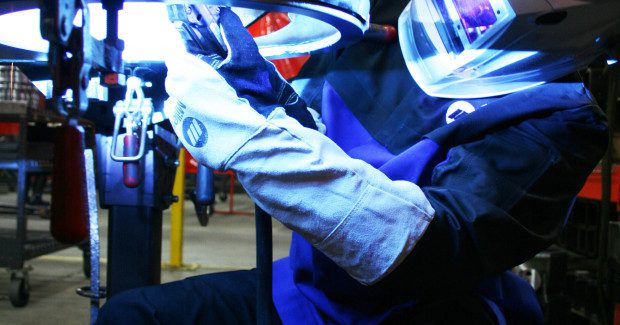How Advanced Welding Information Management Helps Standardize Work Procedures
From the safe unloading of large parts to accurate assembly practices, AWIM systems add value to the welding operation from the beginning to the end of the process by generating valuable insights that improve quality, productivity and the bottom line.
Posted: April 15, 2015
Advanced welding information management (to be referred to here as “AWIM”) systems allow fabricators to capture data that can be used to improve weld quality and increase productivity in any welding operation. In addition to helping the welding operation be as efficient as possible, these software-based tools offer another important value: the potential for significant cost savings.
For example, AWIM systems can track the total cycle time for part completion. Companies can utilize this information to assess the time and labor required to produce each weld and each part. This data, in turn, can be used to streamline the process for greater profitability. Managers and welding operators are empowered to identify and remove non-value-added activities while the work is in progress.
One may ask, “How do AWIM systems help companies maintain consistent workflow to reduce costs?” The answer is simple: These systems create standardized work procedures from pre-weld activities all the way through to the post-weld activities. They display the procedures in real-time on a human-machine interface (HMI) and require the welding operator to acknowledge the completion of each step. As a result, every completed part is the same, regardless of the operator that welds it.
https://youtu.be/edfBZx-SvCI
Having the ability to easily create standardized work procedures and instructions has far-reaching benefits. The cost and potential liability of missed or defective welds can be staggering if they result in a failure in the field. Although mistakes do happen, the earlier defects are detected, the less costly they are to fix. These systems can reduce costs by alerting managers and welding operators to potential welding mistakes in real time. Below are four ways an AWIM systems can help companies standardize work procedures for the best in quality and profitability.
(1) WELDING OPERATOR TRAINING
AWIM systems are used to train new employees and assess the abilities of potential job candidates to see how well they can:
- Read blueprints
- Follow welding procedures
- Use basic tools associated with welding
This training aspect is an invaluable feature for some employers, as the United States anticipates a shortage of as many as 400,000 welding operators within the coming years. Instead of assigning an experienced welding operator to train an inexperienced employee to complete a new task, employers can maximize productivity by letting the system walk the new recruit through the job, step-by-step — leaving the experienced welder to their normal activities. Training can be completed more quickly, resulting in less downtime and less cost. By following the system’s protocol, welding operators in training not only support the quality of the final product, but also improve safety. Companies can program the systems to alert employees to review safety protocols. This may include watching a safety video or being alerted to a change in a technical operations bulletin before work can begin. The cumulative result is streamlined training and safer welding operators.
(2) NON-WELDING WORK INSTRUCTIONS
AWIM systems display part numbers so a welding operator can verify he or she has all of the correct parts needed for a job. In addition, these systems can provide diagrams and step-by-step instructions that show the location of the part and how to load it properly into the appropriate fixture. It is a common task for welding operators to tack weld parts in preparation of welding. These systems can maximize the efficiency of this process by guiding welding operators through the correct tack weld sequence and making certain the welds are properly located and sized. Using the systems to create standardized loading and tack welding procedures gives companies the ability to track costly downtime, as well as additional activities associated with parts being out of tolerance. It also helps companies address tolerance issues at the source.
(3) WELDING WORK INSTRUCTIONS
AWIM systems not only alert welding operators to missed welds, incorrect sequences and over- or under-welding, but they also alert the welding operators immediately when a predetermined welding parameter has been violated. In addition, they provide weld sequencing that takes welding operators step-by-step through the entire process. Welding operators must finish each weld (in the proper order) before proceeding to the next. Weld sequencing offers the following benefits:
- Controls heat input and reduces distortion
- Ensures proper weld placement
- Controls weld parameters
- Prevent costs associated with over- and under-welding
- Ensures the correct number of welds are completed
These systems also support quality control efforts. They have the ability to prevent welding operators from continuing with welding if the minimum requirements are not met. They can stop the welding after detecting a defect or upon determining that a procedure has not been followed. Quality control personnel can receive automatic quality control alerts in this situation, allowing for corrections to be made.
(4) POST-WELDING WORK INSTRUCTION
Last but not least, AWIM systems assist welding operators with post-welding activities, including:
- Proper post-weld inspection of finished parts
- Proper unloading of parts
- Post-weld cleanup procedures
- Post-weld assembly instructions
Having guidance through these steps allows companies to carry through with the quality controls established in earlier areas of the welding operation. From the safe unloading of large parts to accurate assembly practices, AWIM systems add value to the welding operation from the beginning to the end of the process. For shops that wish to gain the benefits of standardizing work procedures, these systems can generate valuable insights that improve quality, productivity and the bottom line. For more information, please click here.





